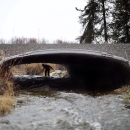States
TexasThis project would create improved road stream crossings and provide reliable transportation access to a community. The current crossings frequently experience floods and washouts that cut off community access to the local town. The FM 2804 Pinto Creek crossing is in the middle of nine miles of Critical Habitat for the threatened species Devils River minnow. The crossing has a high gradient without adequately sized culverts and a perched downstream side, and emergency repairs following a 2016 high water event led to infrastructure that is highly damaging to wildlife. It is critical to remove this barrier as the creek historically goes through periods of drought and drying and the fish need to recolonize the dried areas when re-watered.
Quick Facts:
| Project Status | In Development |
| Location | TX, Kinney |
| NFPP Project Funding | $480,000 |
| Restoration Techniques | Culvert Replacement |
| Accomplishments | 8.5 Stream Miles Reopened |
| Project Partner Lead | Texas Department of Transportation |
| Primary Species Benefited | Devils River Minnow |
The National Fish Passage Program combines technical expertise with a track record of success.
Implemented primarily through the Service's Fish and Wildlife Conservation Offices, the National Fish Passage Program provides financial and technical assistance to partners across the country. Since 1999, the program has worked with over 2,000 local communities, Tribes, and private landowners to remove or bypass over 3,400 barriers to fish passage fish passage
Fish passage is the ability of fish or other aquatic species to move freely throughout their life to find food, reproduce, and complete their natural migration cycles. Millions of barriers to fish passage across the country are fragmenting habitat and leading to species declines. The U.S. Fish and Wildlife Service's National Fish Passage Program is working to reconnect watersheds to benefit both wildlife and people.
Learn more about fish passage and reopen access to over 61,000 miles of upstream habitat for fish and other animals. Staff have expertise in fish migration and biology as well as financial, engineering, and planning assistance to communities, Tribes, and landowners to help them remove barriers and restore rivers for the benefit both fish and people.
Fish passage project proposals can be initiated by any individual, organization, government, or agency. However, proposals must be submitted and completed in cooperation with a Fish and Wildlife Conservation Office. (Please note that fish passage projects being used for federal or state compensatory mitigation or required by existing federal or state regulatory programs are not eligible for funding through the National Fish Passage Program.)
CONTACT A FISH PASSAGE COORDINATOR IN YOUR AREA TO GET STARTED.




